Wheat and Wheat Grinding 101: The Wheat {Types, Where to Buy, and What to Make}
I’ve alluded to this post/series for a while now but I’m more excited than should be deemed rational to finally be bringing you the first installment of the official Wheat and Wheat Grinding 101 series. Perhaps I’m the only one that gets giddy when talking about wheat (Huh? Weird? Me?) but alas, I do and I hope some of this information will be beneficial to those of you interested in wheat and wheat grinding.
I make no effort to hide my deep and abiding love for my wheat grinder and all the benefits it affords me and our family; namely assisting in making our own 100% whole wheat bread for the last three years. However, it took me a while to figure out the ins and outs of wheat and wheat grinding in general.
So over the next few weeks, I’ll be posting two or three more installments for Wheat 101 (including different types of wheat grinders and reviews of those, ways to use wheat and other whole grains, and a whole lot of resources).
Today, let’s talk about the main types of wheat to use in whole grain baking and cooking, the differences between them, where you can buy them and how you can use them in baking/cooking. Whether you make your own bread or not, whole wheat berries/flour can be used in many ways.
Disclaimer: I’m hitting on the wheat varieties that are common, easy to find, and that I’ve used for many years with great success. They are my preferred varieties of wheat but I have friends/family who use other types (like kamut, in particular) so feel free to do your own research on some of those wheat outliers.
Okie doke. Ready? First off, in case you didn’t know, wheat that has been hulled but unmilled (like you see below) is called wheat berries. I’ll refer to “berries” often throughout this post and didn’t want you to be looking for pictures of fresh fruit if you are new to wheat terminology.

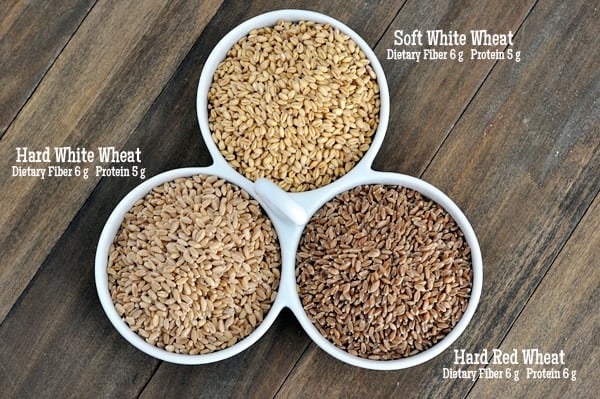 You can tell immediately from these pictures that each type of wheat looks a bit different, both in color and shape. Notice also that for every 1/4 cup of wheat berries, hard red wheat has slightly more protein while hard white and soft white are the same.
You can tell immediately from these pictures that each type of wheat looks a bit different, both in color and shape. Notice also that for every 1/4 cup of wheat berries, hard red wheat has slightly more protein while hard white and soft white are the same.
First up, let’s take a closer look at soft white wheat. The berries themselves are rounder in shape and they are lighter and more yellow in color than the other two types of wheat.
Soft white wheat, finely ground, is perfect for tender, light baked goods. Bread, rolls, and even pie crusts, pastries and cookies.
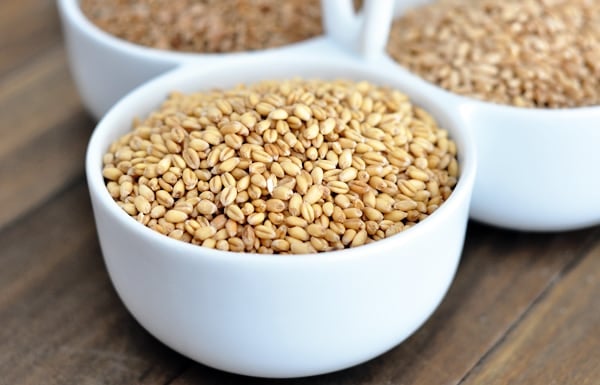
Next, we have hard red wheat. It is noticeably darker than the other two white wheat varieties. Because of it’s slightly higher protein content, it is better used for heartier, heavier breads.
It isn’t going to yield the same light color and texture in a baked good that a variety of white wheat will. Many people who try whole wheat bread with red wheat first are sometimes disappointed because it tends to produce heavy, dark loaves.
I always recommend using hard white wheat to start; for some reason, it seems easier to develop the gluten and get a lighter, more tender bread. I’m not anti-red wheat (you’ll find out more below); but it is the type of wheat that sometimes gives wheat bread in general a bad rep.
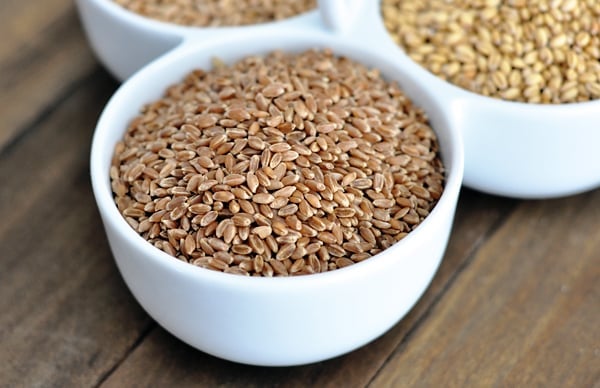
Finally, hard white wheat. Light color, just like soft white wheat, but it has a slightly longer, thinner berry shape. This is the type of wheat I use the most.
It is a great all-purpose wheat flour to use as it works great in yeasted breads/rolls and also in cookies and other baked goods.
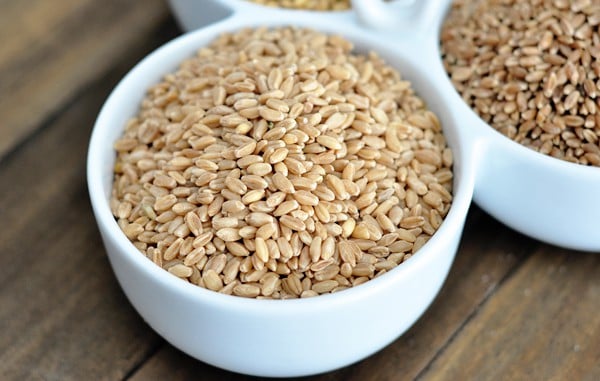
When ground, the wheat berries produce flour at any level of coarseness or fineness, depending on your grain mill or wheat grinder. My rule of thumb, unless I’m going for a cracked wheat cereal, is to grind as finely as my grain mill allows because I like to be able to sub the wheat flour in for all-purpose flour and the more finely ground it is, the more easily I can substitute one-for-one with all-purpose flour.
I’ll be talking more in-depth about wheat grinders in a week or so, but a good rule of thumb is that one cup of wheat berries produces about 2 cups flour. Keep in mind, though, that freshly ground wheat flour is full of air from shooting out of the grinder so measuring freshly ground wheat can be a bit tricky (and is also the reason I use approximate amounts of flour for whole wheat bread recipes instead of exact measurements). I either let the flour settle for 30 minutes or so, or if I’m going to use it right away, I forget my standard flour measuring rule, and pack it in the cup a bit more to account for the airiness of just being ground.
You can see from the picture below that the ground wheat flour varies slightly in color, too, depending on the variety of wheat.
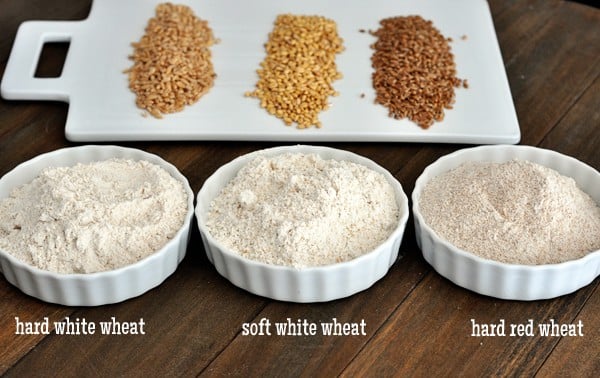
It’s hard to see it in this picture below, but the hard red wheat flour (far right) has a bit more texture and a darker color than the soft white wheat flour to the right.
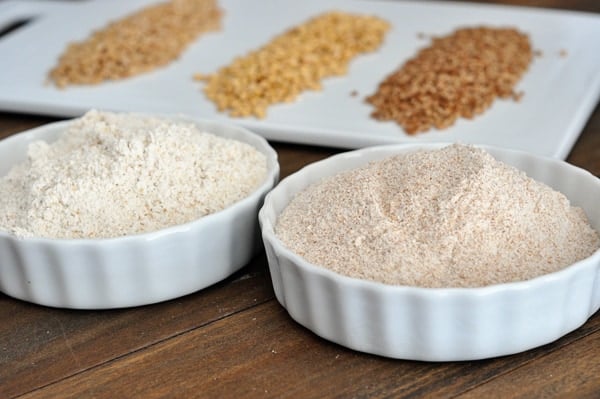
I mentioned above that I prefer using hard white wheat flour. It is definitely what I use 90% of the time; however, I have about 100 pounds of hard red wheat hanging out in storage that I bought 10 years ago that I’m trying to use up, so for the last year, I’ve mixed hard red wheat and hard white wheat (grinding it together) when making bread.
And after shooting pictures for this tutorial, I made bread with all three varieties and what do you know? I think it was the best bread I’ve ever made. So, basically, experiment with the type of wheat you prefer – it will vary widely among every person.

When I lived in Northern Minnesota, I bought it from a local, organic mill near my home (I know, can you believe I moved to the middle of nowhere with an organic grain mill within 40 minutes? Awesome). They do provide shipping if you are interested in checking out their site, but I have to imagine shipping costs are pretty steep since wheat isn’t exactly feather light.
I’ve also found hard white wheat berries at:
- my local Walmart (on the very bottom shelves under the flour)
- Winco (a grocery store in my area in Idaho – they carry it in 25 pound bags)
- a local farm in Ontario, Oregon (Corn Family Farms – check around for any local farms in your area)
There are many, many online sources for wheat, but be aware that shipping costs can run high, so it might be best to check your local resources first. Here are a few online resources (I am not affiliated with any of these but have bought various products from all of them in the past with great results):
Pleasant Hill Grain (probably one of the more reasonable places to buy online)
Emergency Essentials (again, as I looked at their sales/prices, pleasantly surprised)
Shelf Reliance (more expensive but has convenient scheduled shipments, if that floats your boat, and their wheat is non-GMO)
Another resource is the LDS (Mormon) Home Storage Centers. I’m pretty sure you do not need to be a member of the LDS church to can dry goods at the Home Storage Centers (and based on several comments; that’s correct!). Here is a list of Home Storage Center locations; call for details. Their prices are extremely low, in part because you have to/get to pack it and seal it yourself either in cans or mylar bags.
Alternately, if you don’t live near a Home Storage Center, you can order #10 cans of wheat online at store.lds.org. It runs about $33 for 30 pounds of wheat (they only offer hard white or hard red wheat) and shipping is free, although you do have to live in the continental United States to order online (thanks for your comments clarifying that!).
Feel free to share any other resources you’ve found for buying wheat in the comments!
![]() A quick note on storing wheat berries: as with most dry goods, they should be stored in a dry, cool place. My sealed cans and buckets are kept in our basement storage (wheat, if stored properly, can be kept for up to 20 years or longer!) but I keep a large 50 pound bucket in my kitchen that I fill up with the #10 cans or bags of wheat that I buy or bring up from my personal storage.
A quick note on storing wheat berries: as with most dry goods, they should be stored in a dry, cool place. My sealed cans and buckets are kept in our basement storage (wheat, if stored properly, can be kept for up to 20 years or longer!) but I keep a large 50 pound bucket in my kitchen that I fill up with the #10 cans or bags of wheat that I buy or bring up from my personal storage.
This bucket is not sealed, meaning, it won’t keep out bugs or little hands that like to let the wheat run through their chubby fingers, but I use this wheat up quickly and regularly, so as long as I keep the lid closed, I’ve never had problems with bugs (although those pesky little hands still find their way in!).
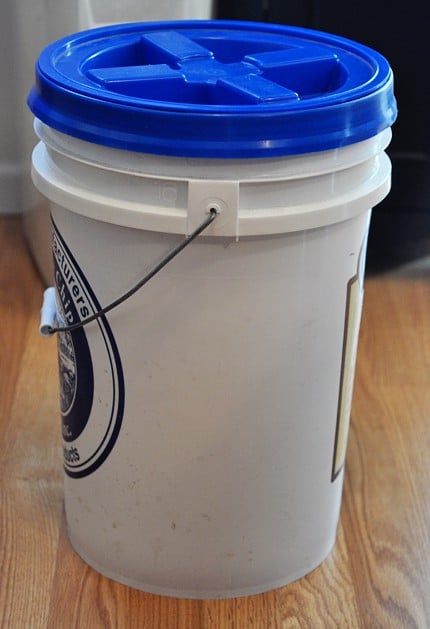
The lid is a nifty two-piece plastic ring with a lid that screws on and off. It is brilliant and saves me from prying off the original lid that came with the bucket.
These two-piece lids (sometimes called Gamma Seal Lids), meant to be used with food-grade 50# buckets, can be found online at any of the wheat resource links above (here is a link from Pleasant Hill Grain).
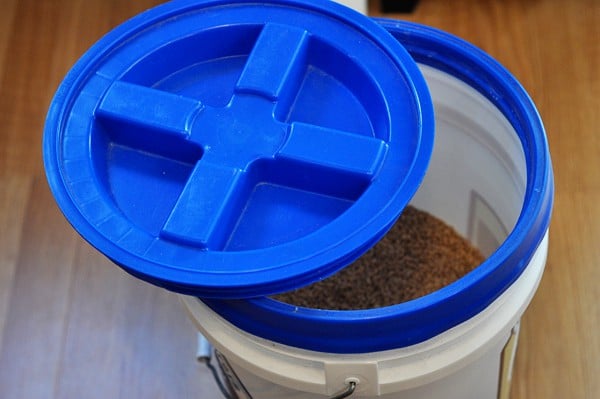
Now on to the good stuff.
![]() The obvious answer is clearly to use it in breads and rolls (but scroll down for some ideas that are a bit outside of the bread box). I have dozens of yeast recipes on my site and while I haven’t specified in each and every one, it’s a given that any time I make rolls or bread, I use whole wheat flour in place of all-purpose flour.
The obvious answer is clearly to use it in breads and rolls (but scroll down for some ideas that are a bit outside of the bread box). I have dozens of yeast recipes on my site and while I haven’t specified in each and every one, it’s a given that any time I make rolls or bread, I use whole wheat flour in place of all-purpose flour.
For bread, I always use my trusted 100% whole wheat recipes. For rolls and other breads, I generally use at least half whole wheat flour, sometimes more and sometimes less (with the exception of this ciabatta bread, this rustic crusty bread and a small handful of others which I always splurge and make 100% white flour).
However, you can think outside of the box and use wheat berries in many other ways besides bread. Here are some good ones:
- Homemade Cream of Wheat Cereal: Toast the wheat berries in the oven until lightly golden, let them cool, then grind them in a grain mill or wheat grinder to the texture of hot cereal, not fine like flour but not as coarse as cracked wheat. You could probably even do that in a blender. Cook or microwave 1 cup of the toasted ground wheat berries in 3 cups water for a delicious, hot cream of wheat breakfast (this is honestly one of my boys’ favorite breakfast choices with blueberries and a touch of brown sugar and milk).
- Pancake Mix: I use 100% whole wheat flour for our favorite oatmeal pancake mix. It’s hearty, healthy and totally delish.
- Traditional Cracked Wheat: If your wheat grinder can hack it, grind the wheat berries for cracked wheat cereal.
- Whole Wheat Blender Pancakes/Waffles: This unique recipe doesn’t use flour at all; it starts with whole wheat berries that are blended with buttermilk and other ingredients. It’s another breakfast staple at our house. You can use any type of wheat berry for these.
- Wheat as a Meat Extender: You can get all wild and crazy and use wheat as a meat extender. It’s amazing! My friend Jenna told me about this years ago after she served me stroganoff that was so tasty, I asked for the recipe and she shyly admitted that the “meat” in the recipe was at least 1/2 wheat berries. WHAT? I couldn’t even tell. It’s been years since I’ve employed this method myself (I need to start again!) but I can vouch that it works. The wheat takes on the taste and texture of the meat plus it adds a whole lot of extra protein and fiber. Basically you use cooked wheat berrries (cracked wheat) and simmer it with your meat (for tacos, stroganoff and other ground beef/turkey meals that simmer or cook for a bit). Google “wheat meat extender” and you’ll get some good ideas.
Well, I think that does it for today! Next up will be a thorough look at wheat grinders. Yahoo! (Seriously, stay in your seats, people.)
Please feel free to leave any questions in the comments and I’ll get to them as soon as I can; alternatively, I’d love any suggestions about the discussion today. I have a feeling I can learn a lot from all of your experiences with wheat, too!

How is best way to clean soft white wheat berries from the farmers field?
Your information was so helpful! All the links andcrevioes!!!
Someone gave us 5 of the #10 cans of hard red wheat. We bought a used grinder (magic mill III) from MARKETPLACE! So it’s been amazing.
So good to see a post on wheat berries, I really enjoyed it. I bought white wheat berries at my local Winco, (Meridian Idaho) and was unsure if they were soft or hard. Looking at your pictures I think they are the soft ones. I’ve lately renewed my obsession of baking bread and rolls and want to use the healthier berries. I have a Magic MIll III that I bought on EBay a year ago and am having fun grinding my own wheat. Looking forward to some other recipes.
Kathryn
If you don’t mind my asking, how much did your grinder cost. Are they very expensive?
Great info! Just starting out in homesteading and this seemed daunting until I read this post.
I’m just getting in to grinding my own flour so your info here was very helpful. I was most interested in what kind of wheat berries for which use and you covered that well.
I am wondering and can’t seem to find an answer. Is it cheaper to grind your own flour? I was lucky enough to be able to buy a 50# bag of king Arthur’s flour for $35 dollars. The prices I see for wheat berries are like $40 for a 5# bag ( just an example) so I am a bit confused
Thanks for any help
Becky
It all depends on where you buy/source the wheat berries and flour from to decide if it’s cheaper to grind your own flour. A lot will depend on that!
I like very “yeasty” tasting rolls. In the past the recipes I’ve found for bread are good but they don’t have a strong yeast taste. Do you have a recipe for those?
I’m guessing it might just depend on the definition of “yeasty” but one way to get that pronounced flavor is to increase the yeast and also let the dough slow rise/ferment in the refrigerator for a day or two.
Two things:
1. Question: Have you had experience with einkorn berries? If so, could you relate your experience with it.
2. Comment: If you use weight rather than volume for measuring out the berries, then there is no need to covert portions of unground vs ground berries. I just weigh out 500g of berries to get 500g of flour.
Great tip on weighing the amount of berries! And yes, I use einkhorn wheat almost exclusively now. It grinds wonderfully well and resembles the texture and results of soft white wheat.
What is your suggestion for grinding organic white flour for sourdough bread. I have been buying a 25# bag directly from mills. I need a strong bread flour for the sourdough. I would like to build an emergency storage of the wheat berries since they store longer than already ground wheat. What type of wheat berry and grinder do you suggest for my purposes?
I don’t have a lot of experience using white whole wheat (or any kind of whole wheat) for sourdough, but I think it could work quite well. I recommend using hard white wheat. Most wheat grinders will grind the hard white wheat really well.
Love to know about Wheat and Wheat Grinding 101 series, thanks for sharing about this with us .
Hello, I’m new to wheat berries, looking at making my own with a very basic recipe, flour, yeast, water, salt! baking will be on the Dutch oven! My ultimate goal is to make my break with my own sourdough started
Which kind of berries would be best for this?
Which kind of berries would be best for cakes, cookies?
what about the berries that say winter or spring?
any help will be appreciated
An
Hi Ana, I think the best wheat to use for almost all of those things is hard white or soft white wheat. Some of them may say winter or spring, but that won’t matter so much. I’d suggest using white wheat berries instead of red wheat berries.
i made a loaf of bread with hard red wheat flour i ground myself and it will not bind? i added a little more water and it still wouldnt bind?
Hello. I’ve heard from the “Bread Beckers” @breadbeckers.com – that using lecithin will help keep your bread together. There is a soy lecithin but they recommend lecithin from sunflower.
Any recommendations for a hand grinder that would work if you have no power source?
I’m still on the hunt for a good option for if/when the power goes out! I haven’t been super motivated since I figure if the power goes out, I’m likely not going to be baking bread or cooking much anyway.
This one:
WONDERMILL Hand Grain Mill Red Wonder Junior Deluxe- Manual Grain Mill and Grain Grinder for Dry and Oily Grains – Kitchen Flour Mill, Grain Mill Hand Crank and Spice, Corn, Wheat Stone Mill Grinder https://www.amazon.com/dp/B009PTZQ10/ref=cm_sw_r_cp_api_glt_fabc_7B437G27N78B3Q6N6Z19?_encoding=UTF8&psc=1
Excellent tips, btw! I’ve been looking for ways to improve my already quite tasty french bread loaves. Best thing I’ve used so far is a ½” deep cookie sheet under the loaf “W” about 6″ apart, with the bread in the center of the oven, and the water pan at the bottom. I usually use a quart of water in the pan, and bake the bread at 425° F (220° C) for 20~30 minutes, looking for that special “golden” crust color that I like. Comes out very chewy (in a nice way) and flavorful (I just ate some freshly baked up with some hearty beef’n’vegetable soup), but with a slightly firmer crust. Still working on developing that crunchy/crispy crust to go with that nice chewy center. Safe, and hoppy travels from the Boondocking Brewer and Baker™!
I forgot to mention that I use Great River Organic Milling, Lily White Bread Flour for all my baking, and also their Dark Rye flour, for my love of dark rye bread. Just remember to add 10-20 gms of gluten flour to the loaf for a perfect loaf of bread! Their Whole Wheat also comes in either white, or red, depending on your needs. They’re a great miller, and the flavor is awesome. Plus, by buying through Amazon, you don’t have to pay for shipping! https://www.amazon.com/Great-River-Organic-Milling-White/dp/B00CTLAIH8/ref=sr_1_2?dchild=1&keywords=Great+River+Organic+Milling&qid=1628133049&sr=8-2
Thanks for this! I have a bunch of soft white and was told it wouldn’t be good as bread flour. Can I add vital wheat gluten to it to give it the protein boost to make yeast pizza crust or similar? If so how much would I trade out? Seems like I read somewhere you can swap a Tbsp all purpose with gluten to make it into bread flour but wasn’t sure if this would work with the soft wheat?
I’m not entirely sure, but you could try adding a tablespoon of gluten for every cup of flour (reducing the flour by one tablespoon). 100% whole wheat baked goods (for pizza crust and other things) will have a different texture than using all-purpose flour. So I don’t think using all soft white wheat will ever approximate the same texture as 100% bread flour, but it can still work quite well.
Hello, We ground our own hard red and when my husband makes a loaf of bread its sooo dense and heavy. Is he doing something wrong? Can we mix hard red and hard white to get something less dense?
HELP!!!!
Yes, I suggest mixing hard red and hard white wheat together for a lighter bread or using all white wheat
Is flour made from any of the wheat berries above considered “whole wheat”? What makes white flour different from whole wheat flour? Also, how do you seal buckets for food storage?
Any flour ground from wheat berries is considered whole wheat. White wheat flour is just lighter in color and texture but it is still considered whole wheat. I usually buy buckets already sealed for food storage so I’m not sure how to seal them yourself.
Can you explain the meat extractor process. Do you soak the wheat berries first. This is awesomeness. I like this idea. Thanks.
Is your post on grain grinders on Pinterest?
Is there anything you need to add to the wheat after you grind it in order to make bread?
Here’s a post on making whole wheat bread at home, Cyndi: https://www.melskitchencafe.com/whole-wheat-bread-step-by-step/
While reading comments I saw one from December 2018. It was asking about the weight of the finished flour when measuring it out for recipes. King Aurthur Flour website has every flour, every weight you could ever need. Click on the drop down menu, click on ingredient weight chart. They also offer on line chat and over the phone help with experienced bakers.
The pandemic has us wanting to try new things
I ‘popped’ some wheat berries but they still are too hard for my teeth. My plan was to maybe grind them up for flour. Do you think it would work for bread or do you think it lost it’s bread making power?
I use wheat berries all the time to make a loaf of cracked whole wheat bread. Just take 67.5 gms of whole wheat berries in 100 gms of water, and boil for 90 seconds (I use my 1500 watt microwave for this part), then let them rest until all the liquid have been absorbed. Then add the precooked berries to your regular whole wheat bread recipe. I use Bob’s Red Mill Organic Wheat berries, and they are partially milled with a coarse “cracking” that makes them superb in a 100% whole wheat bread.
How do you make cracked wheat cereal? Thanks!
I live on the Island of Vancouver , and I just found Organic local wheat kernels. Seems only the hard red spring wheat is available here. I have a Magic Mill which has been resting for years, and a faithful Bosch machine with a dough hook . Do you ever add extra gluten leavening ? Started again making bread because of the pandemic and I am hooked for good! Can’t wait to use fresh flour again!
Yes, I will often add gluten flour!
Do you use all freshly ground wheat in your cookies, bars, pie crust and cakes too? I’ve never ground my own wheat, would love to try, but the price of a grain mill right now isn’t an option. I grew up with my mom mixing 1/2 all purpose flour with 1/2 whole wheat flour in a large container and just using that for everything she baked. And she didn’t make yeast products at all. I didn’t like wheat flour in everything! My biggest complaints growing up were chocolate chip cookies and banana bread as they were heavier than what my friend’s mom’s were! I learned later in college that mixing them is fine, but not always at half ratios, because some things taste better with less whole wheat, so it’s better to mix in individual recipes based on the need. I find the store bought whole wheat flour is much heavier, and I tend to not use it, because of the texture it seems to impart. So maybe another question is… when just were starting out with wheat flour, how did you do it/transition? And did your family complain? The hardest part of wheat and whole grain baking to me, is it is different, and my family doesn’t like it! Which I get as I didn’t like wheat flour in things as a kid either, and still don’t prefer the heaviness of baked goods when I use boughten whole wheat flour. Yet I think freshly ground flour could be good for us! Thanks for your tips and insight on this! I find it fascinating even if it might be awhile before I try to grind my own!
Hi Mary Ann – it definitely takes some getting used to if you aren’t used to the taste/texture of whole wheat. I’d suggest using 25% whole wheat to 75% all-purpose flour and gradually increasing the whole wheat as your family gets used to it!
Do you wash the berries before grinding?
No, I do not.
Can I make wheat flour in my Vitamix?
It’d probably be best to google that question or contact Vitamix directly as I haven’t tried it myself.
Hi Carolina..idk if you have gotten a response or not but vitamix makes a blender specifically for dry mixes. I have made brown rice flour and wheat flour in my vitamix dry mix container and pr works beautifully.
Tami
I got some hard red wheat in Montana and have it stored in a large plastic container. Went to grind some and there is as much flour like substance (but more creme color) as there as the wheat berries in the container. No bugs. Now is the grain still good to use and should I wash the berries and dry them before grinding??? Am a beginner as you can tell.
Hi Helen, honestly, I’m not sure. I’ve never had that happen – can you call the manufacturer or store where you purchased the wheat?
I want to make cracked wheat cereal. I have a small mill that I grind my flour for bread. I would like to know which setting I should use on my mill for cracked wheat cereal. The range is from one to five with #one producing the finest flour. Do I use #five for the most coarse for cracked wheat cereal or is this just a personal preference thing?
I think it’s totally a personal preference thing but I’m guessing it will be between 4-5
Thank you for this! I am so very confused about using the hard red wheat vs hard white wheat for making sourdough boules. I started looking into this because there are absolutely no bread flours available in the city I live in due to the virus. I wanted to ask, if I want to make a classic artisanal bread with soft and open crumb, and crispy crust, how do I use these flours? Am I supposed to use part hard white wheat flour (or red) and add conventional bread flour? Or do I use part hard white wheat and part hard red wheat? Or would that be super dense?
I think using all hard white and hard red would make a fairly dense artisan bread but using half hard white wheat (that’s my preference; I don’t like using hard red wheat) and half all-purpose or bread flour would be a good solution.
I think that this is because most hard red wheat is used in the brewing industry for its lower than usual protein component. White white (usually malted like hard red wheat) of the soft white variety is mostly used in brewing Belgian style Wit beers. The hard white is used more for bread, as it’s higher molecular weight protein structure lends itself to baking bread, rather than for brewing. You can get all four varieties at your local home beer and wine trade stores for relatively decent prices. Malted varieties will be sweeter, and darker, due to the non enzymatic browning that takes place (Maillard reactions), and will make for a darker and crispier crust, much like what milk gives you from the lactose.
Thank you, I haven’t ground wheat for probably 35 years now.. I guess that indicates how old I am. In lite of these times we are living in I have decided to start that up again. Glad you are out there and hope to be reading more articles..
This article was so informative and to the point. I loved it. Thank you for writing it.
I’ve been using hard white wheat berries for a long Time but with the flour shortages with COVID 19, I’m considering trying out soft white wheat berries in place of my missing all purpose flour for the cookies and dinner rolls and artisan bread and all the other things I prefer to do not 100% whole wheat. Thoughts on this? I would probably do 50/50 hard white and soft white in all my recipes calling for all purpose flour…
It’s definitely worth a try! It doesn’t matter whether it’s soft or hard wheat in the sense that using 100% whole wheat for recipes that you’ve used 100% white flour in the past will make a difference to overall taste and texture. But that’s not a bad thing. I recommend measuring with a very light hand when using all whole wheat flour and using part soft and part hard white wheat will make a lighter texture for sure!
Okay, this may seem like a dumb question, but it’s genuine. Why should I want to grind my own wheat berries? Is the taste superior to whole wheat you can buy in the grocery store? Is the cost more effective? Or is it just the fun challenge of doing it yourself? I’m all about any or all of those reasons, but I don’t personally know anyone who grinds their own wheat berries so this all seems a bit radical to me. Thanks Mel.
Great questions, if you buy wheat berries in bulk, it’s definitely more cost effective – and when grinding at home, you can often grind the flour more finely than the flour found in the stores.
Oh, there is a much better reason to grind your own wheat berries than just the cost! The health benefits of freshly ground wheat are tremendous! The flour in the stores have had something like 26 nutrients removed to make it shelf stable and then 4 added back in and called enriched. Wheat starts to degrade immediately when ground, so grinding it fresh is always best. My mother, who cannot eat any wheat products without getting sick, is able to eat anything I make with freshly ground wheat – I’m sure it’s because everything is in the flour that God intended to be there for our bodies to process it. 🙂 Check out The Bread Beckers for much more information on this.
Monica, thank you for such a great reply.
For decades I have been baking my own bread and other items with whole wheat flour I grind at home with an electric grinder (The Kitchen Mill by BlendTek now but started with one by Bosch). So my question is the flour I grind as bad for us—quick carb, sugar spike wise—as the white flour most people eat? I mean does it spike our blood sugar and therefore should be eliminated from our diets—as many experts now say?
Sue Becker of The Bread Beckers says this: “True whole grains, eaten in their whole form or freshly ground into flour, with nothing added and absolutely nothing removed, is very different nutritionally from the commercially produced “whole grain” products. True whole grains will reduce cholesterol, stabilize blood sugar and prevent obesity by satisfying one’s appetite.”
I don’t have a grain mill. Can I use a blender or food processor to grind wheat berries into flour?
I’ve heard you can but haven’t tried it myself. I’m not sure how finely it could grind the berries into flour.
You need to have a dry grain attachment for a blender, otherwise, a grain mill or coffee grinder will work.
I’m just now looking into hard red wheat! I’m excited to start this process. Would a Cuisinart work efficiently in grinding up the wheat? I’m also wondering if using hard red wheat would require me changing all my bread recipes I already have?
Bread Beckers is a family run business in Georgia that sells wheat berries. They have coops to reduce shipping costs. They are also very helpful if you call.
Breadbeckers also sell grinders and have videos to show the differences between mixers and grinders. Their videos are very informative.
Thanks for info; will have my wife study this.
We purchased a large load of dehydrated foods about 6 years ago and have decided to delve into the hard wheat. We also have a grinder and a mixer for making breads. I look forward to reading more of your info and trying your recipes. Thank you.
Hello! Thank you for all your thoughtful suggestions and comments. I have been using whole wheat for awhile, and everything tastes better and better for you. But.. I am having a hard time making fluffy cakes. what berries do you use to make fluffy cakes? Do you alter the recipe when you are not using store bought all purpose flour?
Hi Mary – Have you tried whole wheat pastry flour (or if you are grinding your own, grinding the flour at the finest level and then sifting through a strainer)? That may help, but truthfully using whole wheat flour will probably never yield quite the same light and fluffy cake as cake or white flour. If I’m using whole wheat flour in a cake, I usually use half wheat/half white flour. It’s still a little more dense than normal, but pretty tasty.
do you know the weight of a cup of ground flour for the hard red, hard white, and soft white respectively?
It really depends – if it’s straight out of the grinder, it’s going to be super fluffy, probably right around 4 ounces. But if it’s had a chance to settle, it’s more like 5 ounces.
Greetings Mel,
I will be using already ground up Spelt flour. Have you tried it? It taste so good. One can get adducted to it. It’s an ancient grain.. Thank you for the tutorial you have done and now I shall go check out your small new small amount batch recipe. Thanks!
Do you wash and dry your wheat berries before grinding?
No I don’t.
So I am completely new to this and the only thing stopping me from starting is what type of wheat I should buy. I make bread nd rolls occasionally but mostly others things like cookies cakes pumpkin bars pies and cinnamon rolls and everyday cooking. What type of wheat should i get that will get me close to the all purpose type use?
I would suggest using hard or soft white wheat.
Do u how to and where I can find an old soaker? Spinner? To take the berries to make “wheat meat..like seitan. goodwomn43@yahoo.com
Apologies for the completely newbie question, but I’m wanting to make just regular white bread, not wheat. Do I still use the soft white wheat berries to grind just regular white flour? I think the word “wheat” in “wheat berries” is throwing me off and making me think the only thing it’ll grind down to is…well, wheat flour, not white. Help?
Hi Rose, if you want to make white bread, you’ll want to use all-purpose flour – you can’t achieve that type of flour by grinding your own wheat at home.
I agree with Mel in this regard. I use the Great River Organic Milling Lily White Bread Flour as my main white flour. S&H is free at Amazon, and it’s really quite affordable. All “berries” mean is the raw uncracked or unmilled wheat kernel from the wheat seed. They use mostly hard red wheat (most of what is sown in the USA, and Canada, eh?) and it looks slightly yellowish under neutral LED lighting due to their aging process after milling. Makes great white bread (I just baked a loaf of French bread today) with good tight crumb, moist body, and chewy crusts. IIRC, they use 14% protein wheat that have a high gluten content. I only use vital wheat gluten with their multigrain, wheat, and dark rye flours. The Lily White needs no extra gluten, so you’re good to go as is with this flour.
Hi, do you know if it’s normal for some wheat berries to have dark tips. Mine have been stored correctly for 6 years but several of them have dark ends (where it was connected to the plant). They don’t smell bad or rancid. Thanks.
I don’t know if that is normal or not, Sandy – have you tried doing a quick google search?
Thanks for your reply. I’ve search the web, but can’t find that issue. All I find is that if they’re bad you can tell by the smell. But mine smell normal. Thanks.
As a brewer, the tips come from harvesting the wheat a little earlier than what the plant is ready for by a few days or so. This helps with the threshing, and gives a slightly higher yield per acre sown. All depends on what the miller elects to buy from the farmer. Another good reason to support Great River Organic Milling! There may be some darkening in your bread, as compared to what you’d see with fully ripened berries, but it takes a spectrograph to really see the differences IMHO. Most brewer’s don’t care about that, just the protein levels, and the Kolbach numbers (malt conversion power) to convert those starches into fermentables, and dextrins.
Do you need to rinse the wheat berries before you put them in your milk to grind them into flour?
I never rinse the wheat berries before grinding.
Bless you for writing this article. Excellent work.